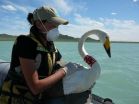(Press-News.org) Researchers have debated for more than two decades the likely impacts, if any, of global warming on the worldwide incidence of malaria, a mosquito-borne disease that infects more than 300 million people each year.
Now, researchers from the London School of Hygiene & Tropical Medicine and the University of Michigan, with colleagues, are reporting the first hard evidence that malaria does—as had long been predicted—creep to higher elevations during warmer years and back down to lower altitudes when temperatures cool.
The study, due to be published in Science and based on records from highland regions of Ethiopia and Colombia, suggests that future climate warming will result in a significant increase in malaria cases in densely populated regions of Africa and South America, unless disease monitoring and control efforts are boosted and sustained.
Menno Bouma, Honorary Senior Clinical Lecturer at the London School of Hygiene & Tropical Medicine, said: "Traditionally, we think of malaria as a disease with limited prevalence in highland regions, but we are now seeing a shift due to climate change. Our latest research suggests that with progressive global warming, malaria will creep up the mountains and spread to new high-altitude areas. And because these populations lack protective immunity, they will be particularly vulnerable for severe morbidity and mortality."
This latest study is the culmination of research which began over 20 years ago at the London School of Hygiene & Tropical Medicine, when malaria and climate data was first collected in the Debre Zeit area of Ethiopia.
It had been predicted that malaria as a disease could be especially sensitive to climate change, because both the Plasmodium parasites that cause it and the Anopheles mosquitoes that spread it thrive as temperatures warm. But some of the assumptions behind those predictions were criticised, and more recently, some researchers have argued that improved socioeconomic conditions and more aggressive mosquito-control efforts will likely exert a far greater influence over the extent and intensity of malaria worldwide than climatic factors.
What's been missing in this debate has been a detailed analysis of regional records to determine how the spatial distribution of malaria cases has changed in response to year-to-year temperature variations, especially in countries of East Africa and South America with densely populated highlands that have historically provided havens from the disease.
Bouma and his colleagues looked for evidence of a changing spatial distribution of malaria with varying temperature in the highlands of Ethiopia and Colombia. They examined malaria case records from the Antioquia region of western Colombia from 1990 to 2005 and from the Debre Zeit area of central Ethiopia from 1993 to 2005.
By excluding other variables that influence malaria case numbers, such as mosquito-control programs, resistance to anti-malarial drugs and fluctuations in rainfall amounts, they found that the median altitude of malaria cases shifted to higher elevations in warmer years and back to lower elevations in cooler years. The relatively simple analysis yielded a clear, unambiguous signal that can only be explained by temperature changes, they said.
In the Debre Zeit region of Ethiopia, about 37 million people live in rural areas at risk of higher malaria exposure under a warming climate. In a previous study, researchers estimated that a 1 degree Celsius temperature increase could result in an additional 3 million malaria cases annually in Ethiopian children.
"This is indisputable evidence of a climate effect," said Mercedes Pascual from the University of Michigan. "Our findings here underscore the size of the problem and emphasize the need for sustained intervention efforts in these regions, especially in Africa."
The authors note that their work is limited to two countries on two continents, and should be replicated in more countries with malaria in highland regions before more general trends can be assumed.
INFORMATION:
For more information, to request interviews or to receive a copy of the research paper, please contact the London School of Hygiene & Tropical Medicine press office on +44 (0)207 927 2802 or press@lshtm.ac.uk.
Notes to Editors
A. S. Siraj, M. Santos-Vega, M. J. Bouma, D. Yadeta, D. Ruiz Carrascal, M. Pascual. Altitudinal Changes in Malaria Incidence in Highlands of Ethiopia and Colombia. Science. DOI: 10.1126/science.1244325
Link to study once published: http://www.sciencemag.org/lookup/doi/10.1126/science.1244325
Photos available at http://bit.ly/1i3jNWE
Warmer temperatures push malaria to higher elevations
2014-03-06
ELSE PRESS RELEASES FROM THIS DATE:
Scientists create detailed picture of protein linked to learning, pain and brain disorders
2014-03-06
LA JOLLA, CA, and NASHVILLE, TN – March 6, 2014 – Researchers at The Scripps Research Institute (TSRI) and Vanderbilt University have created the most detailed 3-D picture yet of a membrane protein that is linked to learning, memory, anxiety, pain and brain disorders such as schizophrenia, Parkinson's, Alzheimer's and autism.
"This receptor family is an exciting new target for future medicines for treatment of brain disorders," said P. Jeffrey Conn, PhD, Lee E. Limbird Professor of Pharmacology and director of the Vanderbilt Center for Neuroscience Drug Discovery, who ...
Warmer temperatures fuel spread of malaria into higher elevations
2014-03-06
In the tropical highlands of South America and East Africa, cool temperatures have historically kept mosquito-borne diseases, such as malaria, at bay. New research by Howard Hughes Medical Institute (HHMI) scientists shows that as annual temperatures rise in these areas, malaria can spread to populations in higher elevations that had historically not been at as much risk of being infected by malaria parasites.
HHMI scientists have compared the yearly distribution of malaria cases in two mountainous regions in South America and East Africa, and found that in warmer years, ...
Birds of all feathers and global flu diversity
2014-03-06
A group of international scientists have completed the first global inventory of flu strains in birds by reviewing more than 50 published studies and genetic data, providing new insight into the drivers of viral diversity and the emergence of disease that can ultimately impact human health and livelihoods.
The research, published in the journal PLOS ONE and performed as part of the USAID PREDICT project, identified over 116 avian flu strains in wild birds. This is roughly twice the number that were found in domestic birds, and more than ten times the number found in humans. ...
Returning vets face 'warring identities' distress
2014-03-06
PROVIDENCE, R.I. [Brown University] — Much of the research on post-combat mental health of veterans focuses on problems like post-traumatic stress disorder (PTSD) and major depression. A paper co-authored by R. Tyson Smith, visiting assistant professor of sociology, takes an even broader snapshot of returning soldiers' mental state by focusing instead on the identity conflict many face when transitioning from soldier to civilian life and how that conflict manifests as mental distress. The paper was published in the January issue of Society and Mental Health.
"You can't ...
Colored diamonds are a superconductor's best friend
2014-03-06
Flawed but colorful diamonds are among the most sensitive detectors of magnetic fields known today, allowing physicists to explore the minuscule magnetic fields in metals, exotic materials and even human tissue.
University of California, Berkeley, physicist Dmitry Budker and his colleagues at Ben-Gurion University of the Negev in Israel and UCLA have now shown that these diamond sensors can measure the tiny magnetic fields in high-temperature superconductors, providing a new tool to probe these much ballyhooed but poorly understood materials.
"Diamond sensors will give ...
Alzheimer's research team employs stem cells to understand disease processes and study new treatment
2014-03-06
Boston, MA – A team of Alzheimer's disease (AD) researchers at Brigham and Women's Hospital (BWH) has been able to study the underlying causes of AD and develop assays to test newer approaches to treatment by using stem cells derived from related family members with a genetic predisposition to (AD).
"In the past, research of human cells impacted by AD has been largely limited to postmortem tissue samples from patients who have already succumbed to the disease," said Dr. Tracy L. Young-Pearse, corresponding author of the study recently published in Human Molecular Genetics ...
E-cigarettes: Gateway to nicotine addiction for US teens, says UCSF study
2014-03-06
E-cigarettes, promoted as a way to quit regular cigarettes, may actually be a new route to conventional smoking and nicotine addiction for teenagers, according to a new UC San Francisco study.
In the first analysis of the relationship between e-cigarette use and smoking among adolescents in the United States, UCSF researchers found that adolescents who used the devices were more likely to smoke cigarettes and less likely to quit smoking. The study of nearly 40,000 youth around the country also found that e-cigarette use among middle and high school students doubled between ...
Up-converted radio
2014-03-06
Ever worry about losing your mobile-phone reception? The problem is a weak microwave signal. The same problem hampers cosmologists looking at the early universe, a glimpse embodied in the cosmic microwave background. Or take a pressing earthly example: oncologists often locate and identify tumors using MRI scans. All three of these efforts---communications, cosmology, medicine---depend on discriminating weak microwave or radio signals from a noisy environment. A new approach to this important problem provides a clean, all-optical detection of microwaves and radiowaves ...
Discovery sheds new light on marijuana's anxiety relief effects
2014-03-06
An international group led by Vanderbilt University researchers has found cannabinoid receptors, through which marijuana exerts its effects, in a key emotional hub in the brain involved in regulating anxiety and the flight-or-fight response.
This is the first time cannabinoid receptors have been identified in the central nucleus of the amygdala in a mouse model, they report in the current issue of the journal Neuron.
The discovery may help explain why marijuana users say they take the drug mainly to reduce anxiety, said Sachin Patel, M.D., Ph.D., the paper's senior ...
Some people really just don't like music
2014-03-06
It is often said that music is a universal language. However, a new report in the Cell Press journal Current Biology on March 6 finds that music doesn't speak to everyone. There are people who are perfectly able to experience pleasure in other ways who simply don't get music in the way the rest of us do.
The researchers refer to this newly described condition as specific musical anhedonia—in other words, the specific inability to experience pleasure from music.
"The identification of these individuals could be very important to understanding the neural basis of music—that ...



